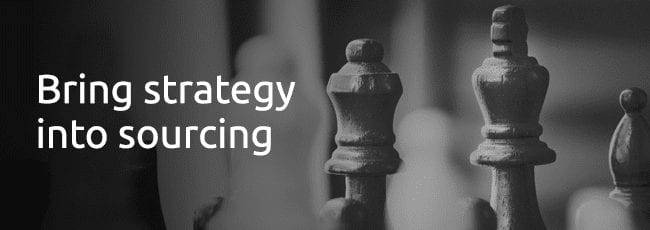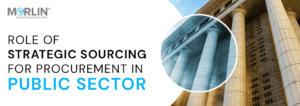As businesses today are navigating through a disruptive and turbulent economic climate, they need to strive to adapt themselves to achieve a robust and sustainable supply chain. It is likely that companies can navigate through most of the unpredictable conditions to a great extent if they can intelligently acquire goods and services, irrespective of the state of the market. Hence, Supply Chain Management professionals should seek out creative and innovative ways that reduce costs and achieve a faster time to market and at the same time assure and improve the quality of the final product.
If you take a look at traditional procurement practices, it can be seen that the focus was primarily on supplier pricing. But in today’s dynamic business scenario, sourcing needs to evolve into a more proactive process with the cost being only one of the components. There should be a focus on other corporate needs as well, such as assurance of supply, service, quality, innovation, and regulatory compliance, none of which can be sacrificed for a lower price.
This demands organisations to see sourcing as a more strategic activity rather than as a tactical activity. Sourcing teams should emphasize the total value or the total cost of ownership and optimize the entire sourcing process. This ensures the purchase of appropriate goods or services from suppliers that meet quality and delivery requirements at the best price.
Table of Contents
ToggleWhat is Strategic Sourcing?
Strategic Sourcing is a holistic approach to supply chain management that continuously improves and re-evaluates the procurement activities of an organization to find the best value by gathering information and being more proactive. While traditional procurement was a short-term activity that focused on initial supplier pricings only, strategic sourcing allows businesses to make their procurement activity less shortsighted and more systematic. It helps develop an adaptable system that contributes to the overall value of the business in the long term.
Strategic Sourcing uses a comprehensive methodology that includes ongoing market & supplier analysis using intensive data analytics and explores various viable avenues in pursuit of cost reduction and overall improvement of quality and sustainability in the supply chain.
Strategic Sourcing – The Process and Steps Involved
Now that we have seen what strategic sourcing is, let’s take a look at the steps involved in strategic sourcing so that you get a clearer picture of what it is all about. Strategic sourcing indeed can have many variations, but it can be commonly broken into the following seven steps

1.Identification and Categorization of Spend Profiles: The strategic sourcing process starts by identifying the spend areas across the business areas in the organisation. It involves analysing the product categories, their spending patterns, the processes and departments, and so on.
2. Develop a sourcing strategy based on business goals: The second step involves identifying the requirements of the business units and defining goals, objectives and corresponding timelines to meet the goals. Based on this, build a strategy on how each requirement of the spend area will be approached.
3. Analyse the supplier market.
The next step in strategic sourcing is to execute an in-depth analysis of the supplier market to evaluate relevant supplier profiles including analysis of the market share of suppliers, their industrial performance, risks and opportunities surrounding the supplier market, etc.
4.Request for Supplier Information
Once the market research is done, request for supplier information to get them registered based on qualification criteria. This information needs to be reviewed periodically to ensure accuracy as well as consistent supplier performance.
5.Initiate Procurement and Identify Selection Criteria
Initiate the procurement process in the form of RFI/RFP/RFQs and receive online responses from the suppliers. At this step, it is important that you communicate your exact requirements, end goals and performance expectations so that the suppliers have a clear understanding of what your organization needs.
The information from suppliers will give you data insights, including the pricing structures, delivery, logistics and warranty provisions, product specifications, etc. based on which you can identify selection criteria for supplier selection.
6.Selection of Suppliers and Execution of the Contracting Process
Based on your selection criteria, choose the suppliers that can offer you the highest value and start with the contracting processes to on-board the selected suppliers. You can have weights from various criteria such as quality, delivery schedules, logistics etc. in addition to price to arrive at the final sourcing decision.
7. Measure and track the performance of suppliers.
The strategic sourcing process does not end with selecting the suppliers, but it extends further by tracking periodically the supplier performance and identifying areas of improvement. This is important to help organisations understand supplier risks and design strategies to mitigate any risks to the supply chain.
8.Implement Supplier Relationship Management (SRM)
Strategic sourcing stresses on making the relationship between the organization and suppliers a closed loop rather than a one-way process. Implementing supplier relationship management can lead to a synergized long-term collaboration and can further improve supplier performance.
9.Advanced Analytics
Strategic sourcing involves continuous improvement based on a deep study of past trends. Spend, Cost, Project Performance, Supplier Performance etc. need to be analysed and reviewed regularly to identify risks, issues in the supply chain as well as potential areas of optimization and improvement.
Benefits of Strategic Sourcing
Strategic Sourcing is a vital component for today’s businesses, with real-world impact on all facets of the business allowing organizations to align their purchasing teams to business goals and the overall value proposition. There are many reasons why making the transition to strategic sourcing is a smart move:

1. Impact on cost – Indeed, the most obvious benefit of strategic sourcing is the improvement in the organization’s bottom line. By selecting suppliers that will provide the highest value at the right pricing, strategic sourcing enables organizations to reduce overall costs, price their goods competitively and increase profit.
2. Risk Management – Strategic Sourcing allows organizations to mitigate risks in their supply chain as it considers elements beyond cost. It facilitates increased understanding of supplier markets, supplier’s sustainability, flexibility, and innovation that can all help identify potential risk factors.
3. Build strong relationships with suppliers – With increased communications between businesses and suppliers, strategic sourcing helps businesses build a healthy and sustaining relationship with their suppliers. It leads to mutually beneficial partnerships with suppliers and can result in faster lead times, more reliable fulfilment with flexibility for negotiation, and higher quality materials.
4. Supply Chain stability – Strategic Sourcing ensures that the present and future sourcing needs of an organisation are laid out well ahead of time and owing to the stable supplier partnerships, organisations can enjoy supply chain stability and avoid having to end up in a situation where they do not get what they need.
5. Continuous Improvement – Strategic sourcing is a continuous cycle of activities rather than a one-time activity where the executives get opportunities to learn more every time and improve on the findings to bring more value to the company.
Getting Started with Strategic Sourcing
As competition increases and margins get tighter, the shift towards strategic sourcing is becoming inevitable for organizations that are looking for savings and competitive advantage. Additionally, in an uncertain business environment, managing fluctuations in demand, risks and disruptions to the supply chain proactively are extremely critical. Many organizations try to manage strategic sourcing with basic spreadsheets and Microsoft office tools. But these are inefficient most of the time and turn out to be inadequate in leveraging the real benefits of strategic sourcing. In order to remain competitive and relevant in today’s chaotic markets, it is necessary to utilize the latest technologies and tools.
Digitization of sourcing activities has been following a slow ramp-up compared to other enterprise activities like finance, sales, etc mainly because most of the procurement objectives were less well covered by transactional IT systems. But, in recent years there has been a gradual development of specialized application suites and software focused on procurement activities including strategic sourcing. Emerging technologies like Artificial Intelligence, Robotic Process Automation (RPA), machine learning algorithms, advanced analytics, and big data bring in enormous automation potential not only in transactional activities, such as order and invoice processing but also in sourcing’s strategic elements, such as spend analytics, vendor selection and management. By leveraging the power of automation technology for strategic sourcing, businesses can optimize their sourcing activities to improve their bottom line significantly. A McKinsey report suggests automating Source To Pay activities can reduce spend by up to 3.5%.
Thus, the automation of strategic sourcing translates to more savings at lesser efforts. Strategic Sourcing software can help businesses streamline and automate their sourcing functions by standardizing sourcing requirements and providing a platform for collecting information about suppliers, products, markets, and business needs.
RheinBrücke’s MeRLIN is a strategic sourcing solution for direct and indirect procurement that allows for greater levels of automation of your sourcing activities and simplifies the complexities surrounding strategic sourcing by leveraging real-time data and advanced analytics tools.
Contact us to know more about MeRLIN and transform your sourcing function to a value-driven strategy that can give you a competitive edge.







One comment
Your article is very valuable for me. Hoping to read more. Thank you.